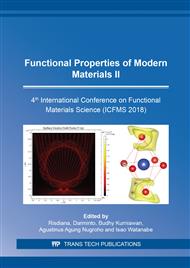[1]
Banyamin, Z.Y., Kelly, P.J., West, G. dan Boardman, J., Electrical and Optical Properties of Fluorine Doped Tin Oxide Thin Films Prepared by Magnetron Sputtering, J. Coating. 4 (2014) 732-746.
DOI: 10.3390/coatings4040732
Google Scholar
[2]
Shaban, Mohammed, G.F. Attia, Mohammed A. Basyoni and Hany Handy, Morphological and Structural Properties of Spin Coated Tin Oxide Thin films, International Journal of Engineering and Advanced Research Technology (IJEART) 79 (2015) 11-14.
Google Scholar
[3]
Batzill, M. and Diebold, U., The Surface and Materials Science of Tin Oxide, J. Programess in Surface Science Elsevier. 79 (2005) 47–15.
DOI: 10.1016/j.progsurf.2005.09.002
Google Scholar
[4]
Amma, D. Sumanggala Devi, V.K Vaidyanand P.K. Manoj, Structural, electrical and optical studies on chemically deposited tin oxide films from inorganic precursors, Materials chemistry and physics. 93 (2005) : 194-201.
DOI: 10.1016/j.matchemphys.2005.03.045
Google Scholar
[5]
Johansson, S., Solution based Methods for Synthesis of Tin Oxide and Zinc Oxide Materials, Wires and Thin Films. (2012) 30.
Google Scholar
[6]
Saryia, D.M., Selma, M.H.A., Noor, M.S., Physical Properties of Indium Tin Oxide (ITO) Nanopartical Thin Films Used as Gas Sensor, Eng. & Tech. Journal 33 (2015) 141-151.
Google Scholar
[7]
Sistesya, D., and Sutanto, H., Optical Properties of Layer Zn:OAg deposited on Glass Substrate Using Method Chemical Solution Deposition (CSD) and Its Application to Degradation of Methylene Blue Dyes, Youngster Physics Journal. 1 (2013) 71-80.
Google Scholar
[8]
Jia, T., Zhao, j., Fu, F., Deng, Z., Wang, W., Fu, Z., and Meng, F., Synthesis, Characterization, and Photocatalytic Activity of Zn-Doped SnO2/Zn2SnO4 Coupled Nanocomposites, Hindawi Publishing Corporation International Journal of Photoenergy. 20 (2014) 1-7.
DOI: 10.1155/2014/197824
Google Scholar
[9]
Gurakar, Electrical and microstructural properties of (Cu, Al, In)-doped SnO2 films deposited by spray pyrolysis, Materials Letters. 5 (2014) 309-314.
DOI: 10.5185/amlett.2014.amwc.1016
Google Scholar
[10]
Garceset, F.A., Acquaroli, L.N., Koropecki, R.R., Arcel, R.D., Current-Voltage characteristics in macroporous silicon/SiOx/SnO2, Nanoscale Research Letter. 7 (2012) 1-6.
DOI: 10.1186/1556-276x-7-419
Google Scholar
[11]
Battal, Comparison Effect of Spin Speeds and Substrate Laters on Properties of Doubly Doped Tin Oxide Thin Films Prepared by Sol-Gel Spin Coating Method, J. of Ovonic Research. 10 (2014) 23 – 34.
Google Scholar
[12]
Lin, Y., Synergistically improved formal dehyde gas sensing properties of SnO2 microspheres by indium and palladium co-doping, Ceramic International. 41 (2015) 7329 – 7336.
DOI: 10.1016/j.ceramint.2015.02.033
Google Scholar
[13]
Felde, Zum, M. Haaaseand H. Weller, Electrochromism of Highly Doped Nanocrystalline SnO2:Sb, J. Phys. Chem. 104 (2000) 9388-9395.
DOI: 10.1021/jp0010031
Google Scholar
[14]
Novinrooz, Abdojavad, Parvin Sarabani, Javad Garousi, Characterization of Pure and Antimony Doped SnO2 Thin Films Prepared by Sol-Gel Technique, Iran. J Chem. Eng. (2006).
Google Scholar
[15]
Hammad, Talaat M. and Naser K. Hejazy, Structural, Electrical and Optical Properties of ATO Thin Films Fabricated by Dip Coating Method, Int. Nano Lett. 1 (2011) 123-128.
DOI: 10.1186/2228-5326-2-7
Google Scholar
[16]
Woo, Dong Chan, et al., Characterization of Sol-Gel Derived Antimony-doped Tin Oxide Thin Films for Transparent Conductive Oxide Application, J. Transactions On Electrical And Electronic Materials 13 (2012) 241-244.
DOI: 10.4313/teem.2012.13.5.241
Google Scholar
[17]
Halim, Abigail, Thin Films Made From Colloidal Antimony Tin Oxide Nanoparticles For Transparent Conductive Applications, Magister thesis, Georgia Institut of Technology. (2013).
DOI: 10.1557/opl.2013.861
Google Scholar
[18]
Hachoun, Z., Ourdane, A., Bouslama, M., Ghaffour, M., Abdellaoui, A., Caudano, Y., and Benamara, A. A., Investigation of The Properties of Sb doping on tin oxide SnO2 Materials for Technological Applications, Materials Science and Engineering. 123 (2016) 1-4.
DOI: 10.1088/1757-899x/123/1/012029
Google Scholar
[19]
Widodo, S., Sol Gel Technology in the Manufacture of Metal Oxide Nano Grain for Gas Sensor Applications, Chemical and Process Engineering, Bandung: PPET-LIPI. (2010).
Google Scholar


